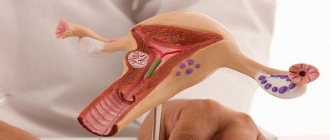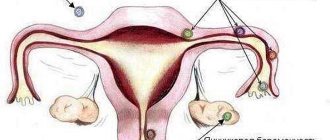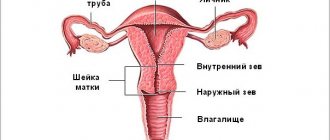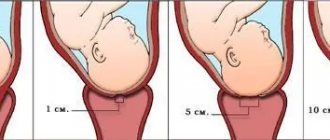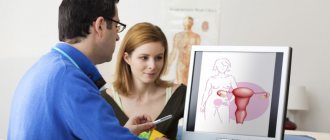The uterus is located in anteflexio - what is it? Let's find out in this article.
Anteflexio is a position of the uterus in which the woman's organ bends anteriorly. The presence of a slight deviation from the norm is not a pathology at all, and at the same time does not pose any threat to women’s health. But, if the uterus is too bent towards the bladder, then problems may arise that will require correction. In this case, the body of the genital organ can deviate forward, and the neck rushes down. If the anteflexio position of the uterus is still accompanied by adhesions, intense pain may occur.
What does anteflexio position of the uterus mean?
If an anteflexio position of the uterus is diagnosed, it is necessary to explain what it is and how the medical term stands for. Normally, the uterus is slightly tilted forward; this is a typical physiologically natural position of the organ.
This position means that the reproductive organ forms two obtuse angles with the axis of the vagina and cervix. Depending on the degree of their filling, the uterus is additionally affected by the bladder and rectum.
If the organ is excessively inclined towards the bladder, this position is defined by the term anteflexio versio, where the first word translated from Latin means “bending forward”, and the second means “inclination” relative to the horizontal axis.
This pathology is much less common than bending in the opposite direction, but without treatment it can lead to negative consequences.
Causes
In some cases, uterine hyperanteflexia occurs due to congenital pathology of the reproductive system acquired during intrauterine development of the fetus. Other reasons for the uterus to be located anteriorly:
- incorrect abortion;
- difficult childbirth, complicated by uterine rupture and large blood loss;
- trauma to the reproductive system;
- adhesions caused by chronic inflammation of the reproductive organs;
- sexually transmitted infectious diseases;
- hormonal disbalance;
- complications after surgery;
- chronic constipation;
- endometriosis.
Deviation of the uterine body from its normal position can be caused by heavy physical labor and athletic sports.
Treatment
The choice of treatment methods depends on the cause of the uterine flexion. If the underlying pathology is infection or an inflammatory process, the following is used:
- drug therapy with antibiotics or anti-inflammatory drugs;
- physiotherapeutic treatment (microwave, UHF) to increase the elasticity of adhesions;
To get rid of adhesions, a low-traumatic surgical treatment such as laparoscopy is performed. After 7-10 days, the patient can return to her normal lifestyle. Other methods for correcting adhesions:
- laser surgery;
- radio wave surgery.
To correctly restore the physiologically correct position of the uterus, Kegel gymnastics is used. These are specially designed exercises to strengthen the pelvic floor muscles. The physiotherapist teaches the patient how to perform them correctly, after which she independently practices therapeutic exercises at home.
Additional methods:
- wearing a bandage;
- wearing a pessary (vaginal ring) to fix the uterus in the pelvis;
- exercises with vaginal balls.
Definition
What is this phenomenon? There are three possible positions of the uterus - normal, when it is located more or less parallel to the pelvic floor, backward, when its body is bent towards the spine, and anteriorly, when it is bent towards the abdominal wall. Anterior bending of the uterus is a less common phenomenon than posterior bending, but it develops for the same reasons.
Types
This disease has different types depending on what caused it:
- A normal deviation is a congenital, physiologically acceptable phenomenon that does not interfere with the patient’s normal life and reproductive function;
- Pathological is a deviation that appears as a result of a pathological process and which can cause significant damage to the body.
Uterine anteflexion is a relatively safe condition that almost never has a negative effect on pregnancy.
Description of this pathology
The uterus in healthy women is in the anteversio and anteflexio position, which means that in relation to the axis of the cervix and vagina it is located at a slight anterior inclination, forming two angles with these organs. When the curvature of the uterus is very pronounced, this indicates excessive or pathological anteflexio, but often doctors omit the term pathological, calling this deviation as anteflexio of the uterus.
Sharp corner
So, this disease is an incorrect location of the female reproductive organ. With such a disease, the angle between the body and the neck turns out to be acute, not obtuse, and it bends towards the bladder.
To put it simply, the uterus in anteflexio involves the bending of a woman’s reproductive organ forward in comparison with its normal physiological position. In the presence of this pathology, the bottom of the genital organ is directed anteriorly, and the vaginal portion of the cervix is directed downward.
What this is—the body of the uterus in anteflexio—is now clear. Let's look at the main causes of this disease in women.
Sharp corner
So, this disease is an incorrect location of the female reproductive organ. With such a disease, the angle between the body and the neck turns out to be acute, not obtuse, and it bends towards the bladder. To put it simply, the uterus in anteflexio involves the bending of a woman’s reproductive organ forward in comparison with its normal physiological position. In the presence of this pathology, the bottom of the genital organ is directed anteriorly, and the vaginal portion of the cervix is directed downward. What this is—the body of the uterus in anteflexio—is now clear. Let's look at the main causes of this disease in women.
Located close to the exit
The cervix connects the vagina and the uterine cavity and has a round shape with a small notch in the middle. It plays the role of a protective barrier and drainage. At different stages of the cycle, this organ functions differently - sometimes the cervix is located far from the exit, on other days it drops low. Depending on its location, you can calculate the time of ovulation.
On what days of the cycle is the organ located low to the exit:
- Immediately after the end of menstrual bleeding, the least favorable days for conception begin. The neck acquires a hard and elastic structure, closes, and descends low towards the outlet. The amount of mucus discharge is minimal, which reduces the risk of infection, since the mucus plug remains in the cervical canal.
- Preparation for ovulation - days 9–12, the cervix begins to change its position, it is no longer located so close to the exit, it opens a little. The epithelium becomes softer, sticky mucus appears, which moisturizes the genital tract. The probability of getting pregnant on such days is no more than 5%.
- Starting from the 13th day, the amount of estrogen in the blood increases, the cervix at the maximum distance from the exit becomes loose. The cervical canal and external os open, and the mucous plug comes out. The structure of the discharge is similar to chicken protein, which facilitates the easy movement of sperm to the egg - this period lasts until the 15th day, which is most suitable for fertilization.
- From the 16th day, progesterone begins to be actively produced, the cervix closes, becomes hard, elastic, located close to the outlet, the pharynx and cervical canal narrow. The discharge becomes viscous, has a sour smell, and a plug forms. The chance of getting pregnant is minimal.
- 12–14 days after ovulation, if fertilization of the egg has not occurred, menstrual bleeding begins, and the endometrium and blood come out through the slightly open external pharynx. The cervix is located as low as possible and has a soft consistency.
This happens with a standard cycle of 28 - 32 days. With a short cycle (21–25 days), the cervix is close to the exit from the first to the fifth and from 13–15 days of the cycle. Accordingly, with a length of 35 - 45 days, the cervix drops close to the exit in the first 7 days of the cycle and the last 6 - 8 days before menstruation.
If a woman notes that the cervix is constantly low, then this sign may indirectly indicate anovulatory cycles. In this case, you should visit a gynecologist, perform folliculometry using ultrasound and donate blood for sex hormones.
Retroflexion of the uterus and pregnancy
When the location of the uterus changes, the penetration of sperm is often difficult, but not completely. Most often, they enter the reproductive tract, but in smaller quantities, which means they may not be enough for conception. Positioning on the stomach and with the pelvis raised at the end of intercourse for 15 to 20 minutes significantly facilitates conception.
The combination of pregnancy and uterine retroflexion is common. With successful fertilization, gradual correction of retroflexion occurs due to the growing fetus. But in severe cases, when the intestinal loops and the reproductive organ are tightly fused, pain or termination of pregnancy may occur, then serious treatment will be required.
Necessary treatment
Only a specialist can understand whether uterine retroflexion needs treatment. If the deviation is slight, the doctor may try to manually return the uterus to its place. This is achieved through a course of massage. If it has returned to the previous “wrong” position, additional diagnostics are needed to assess muscle toning and ligament mobility.
Adhesions and some pathological processes when manually changing position cause sharp pain. In this case, treatment is needed that will eliminate the inflammation and relieve the patient of adhesions. It is also necessary to undergo tests to identify or exclude the possibility of infection.
Retroflexion of the uterus, caused by weak tone, requires special nutrition. It should strengthen the fat layer and increase intra-abdominal pressure. Additionally, physical exercise is required.
The adhesive process is corrected by electrophoresis. If the adhesions are old, they will have to be removed through surgery. Retroflexio caused by endometriosis requires treatment with hormonal drugs.
Fixed retroflexion involves more serious intervention. Timely detection of pathology will allow you to do without surgery. This means that complex therapy will be required, including:
- physiotherapy (UHF, electrophoresis, ultraphonophoresis, therapeutic baths and showers;
- gynecological massage;
- medications (proteolytic enzymes, polyunsaturated fatty acids, mineral complexes, B vitamins);
- normalization of nutrition;
- Spa treatment.
For chronic diseases of the genitourinary system, courses of anti-inflammatory or antibacterial treatment are first carried out.
Anterior bending of the uterus or anteflexion: features of the phenomenon
Features of the clinical picture do not allow diagnosis without ultrasound and colposcopy. Additionally, a smear is taken to identify concomitant infectious pathologies. Most often, anteflexio is recognized during a gynecological examination. If the doctor is in doubt, he sends the patient for an ultrasound examination, which allows not only to identify the pathology, but also to determine the degree of bending of the uterus and possible consequences.
Minor deviations from the norm may not be detected by the gynecologist during a standard examination. However, the presence of a pathological process is indicated by a number of symptoms that help in making a diagnosis: disruptions in the menstrual cycle, pain in the lower abdomen that worsens during menstruation, infertility. Often, in addition to ultrasound, the doctor finds adhesions, endometriotic lesions and other provoking factors of the pathological process.
Depending on this, the condition has a greater or lesser impact on the patient’s well-being, her reproductive function, and does or does not cause characteristic symptoms.
This article discusses the anterior bending of the uterus (anteflexion), its features and the reasons causing the phenomenon. Is it necessary to treat such a condition, in which cases it is not required, since it does not have a negative impact on health?
Definition
What is this phenomenon? There are three possible positions of the uterus - normal, when it is located more or less parallel to the pelvic floor, backward, when its body is bent towards the spine, and anteriorly, when it is bent towards the abdominal wall. Anterior bending of the uterus is a less common phenomenon than posterior bending, but it develops for the same reasons.
Causes
Depending on what causes the uterus to be located in this way, treatment for this condition is prescribed or not prescribed. Typically, anteflexio develops in three cases:
- A congenital condition means that the patient is already born with this arrangement of the organ;
- The adhesive process is the most common pathological cause of the condition, due to the fact that during a chronic or acute inflammatory process in the pelvis and peritoneum, adhesions are formed that “tie” the uterus to the peritoneum or bladder, etc.;
- Weakening of the ligamentous apparatus, muscles and tone of the uterus is much less likely to cause the organ to be in a bent position.
Depending on the causes, symptoms may be less or more pronounced.
Definition
Anteversion of the uterus is the position of the organ when its body is tilted forward. This is a type of forward bend. In this position, the fundus of the uterus is directed forward and slightly upward, as in the normal state, but the inflection between the cervix and its body is more significant. In this case, the location of the neck may be slightly posterior relative to the organ cavity, but at the same time normal, from the point of view of the standard physiological location. For this reason, a bend in the neck may develop.
Quite often there is a phenomenon when the cervix is also subject to bending, as it “stretches” after the organ cavity.
Depending on the reason that caused this phenomenon, the feasibility of treatment and its recommended type (if appropriate) depends. Usually, it is not difficult to establish the cause, since it is often obvious. And by themselves, there are few such reasons. Depending on them, two types of anteversions are distinguished - normal and pathological.
Normal
Normal anteversion is a forward tilt of the uterus that is within acceptable limits, does not interfere with conception and does not cause discomfort, since it does not cause characteristic or uncharacteristic symptoms. Typically, this condition is congenital, that is, the girl is immediately born with this arrangement of the organ, or it occupies it as the reproductive system develops, without causing discomfort. This condition is usually diagnosed accidentally during the first gynecological examination or ultrasound of the abdominal cavity using the transabdominal method (not always).
Pathological
This anteversion develops as a result of a pathological process in the pelvic organs. Most often these are adhesive processes that begin as a result of chronic or acute inflammation in this system. The adhesions tightly fix the uterus, connecting it to the abdominal wall or other organs located nearby.
Another type of pathology is a weakening of the ligamentous apparatus, as a result of which the uterus deviates, but remains mobile. Poor uterine tone and weakening of its muscles may also be to blame.
Possible consequences
What does anteflexio position of the uterus mean, not everyone knows. A common consequence of anterior uterine bending is, first of all, menstrual irregularities. Menstruation may become more profuse and painful with this diagnosis. Moreover, they can begin each time at different intervals.
Incorrect location of the organ turns out to be a provoking factor in the appearance of inflammatory processes. Women may also experience an increased urge to urinate. Endometrial hyperplasia often occurs, which can provoke the appearance of malignant tumors, and, in addition, denomyosis.
The position of the uterus in anteflexion leads to disruption of the bladder and intestines, since this organ exerts sufficient pressure on them. A woman may notice discomfort during bowel movements and urination.
If there is a strong bend, it simply becomes impossible to achieve fertilization. Spermatozoa do not penetrate into the cervical canal. Seminal fluid may instead be retained in the vagina, which often becomes the main cause of inflammation and the development of thrush.
Anterior bending of the uterus or anteflexion: features of the phenomenon. What does anteflexio position of the uterus mean?
What is this phenomenon? There are three possible positions of the uterus - normal, when it is located more or less parallel to the pelvic floor, backward, when its body is bent towards the spine, and anteriorly, when it is bent towards the abdominal wall. Anterior bending of the uterus is a less common phenomenon than posterior bending, but it develops for the same reasons.
Types
This disease has different types depending on what caused it:
- A normal deviation is a congenital, physiologically acceptable phenomenon that does not interfere with the patient’s normal life and reproductive function;
- Pathological is a deviation that appears as a result of a pathological process and which can cause significant damage to the body.
Uterine anteflexion is a relatively safe condition that almost never has a negative effect on pregnancy.
Pregnancy
If the uterus is bent anteriorly from birth, this does not prevent conception and pregnancy. As the fetus grows, the uterus straightens and takes the position it should. The phenomenon does not in any way affect the birth process.
However, in the event of a pathological phenomenon, this position of the uterus can lead to problems with conception as a result of a strong mechanical bending of the cervix. In addition, as the fetus grows, the rations will stretch, causing severe pain. Due to their presence, the birth process may also be complicated.
The main causes of the disease
In gynecology, we often encounter examples of congenital deviation of the named organ from its normal position. In this case, treatment tactics are determined taking into account the degree of inversion and concomitant disease. Acquired anteflexion of the uterus occurs as a result of an improperly performed abortion.
Provoking factors, as a rule, are:
- The presence of chronic infectious pathologies of the pelvic organs in a woman. Pathogens leading to similar consequences include ureaplasma, along with mycoplasma, chlamydia, gonorrhea, gardnerella, trichomonas, and more.
- The consequence of a difficult or complicated birth, occurring with cervical ruptures and heavy blood loss.
- Receiving injuries to the genital organs in certain accidents.
- The appearance of adhesions in the pelvic area during prolonged inflammatory processes.
- Consequence of surgery. Pathology may be a consequence of improperly performed diagnostic curettage, and, in addition, cauterization of erosion, laparoscopic surgery, etc.
- Exposure to excessive physical activity. This is especially true for those women who are interested in bodybuilding and other types of strength training.
Why does it occur
The congenital pathology anteflexion is associated with the individual characteristics of intrauterine development of the fetus.
Anteflexio of the congenital uterus usually does not cause any discomfort, pain, or problems with conceiving and bearing a child, if the bend is slight.
The absence of symptoms in congenital anteflexion is due to the fact that the uterus retains its natural mobility and balances as the body grows.
It’s another matter when the location of the reproductive organ in anteflexion is an acquired pathology. Such a violation may occur as a result of the following factors:
- poorly performed abortion;
- the course of chronic infectious and inflammatory processes;
- difficult and protracted labor;
- mechanical damage to the genital organs;
- consequences of surgical operations;
- adhesions;
- pathological hormonal changes in the body of a drastic nature during the removal of endocrine glands, menopause, adolescence (accompanied by changes in the structure of the ligaments);
- strenuous sports and excessive physical activity.
Separately, it should be noted such causes of anteflexion as intestinal diseases, adnexitis, oncological processes in the pelvis, endometriosis, weak tone of the genital organ ligaments.
In order to prevent the bending of the female genital organs due to such diseases, they must be promptly identified and treated.
Anteflexio position of the uterus, what is it and what does it mean?
The location of the uterus at a slight inclination to the axis of the vagina and cervix, when an obtuse angle is formed, is considered normal. If the body of the uterus is localized under a more pronounced anterior inclination (bending towards the bladder occurs), the uterus is in an anteflexio position, and this can already be considered a pathology.
If such a phenomenon is congenital, it may not in any way affect the reproductive function of a woman. But if the condition is acquired, the severity of the reproductive system disorders will be influenced by the nature of the changes
Such a deviation should be given special attention; with timely treatment, you can get rid of unpleasant consequences
Possible consequences and prognosis
Minor deviations in the position of the organ’s body do not cause any particular complications; the prognosis for conceiving a child and the course of pregnancy is quite favorable. Many women have a congenital form of anteflexio and live with it throughout their lives, not noticing any deviations in their health or in intimate intimacy with their partner.
In the case of the acquired form, the situation is a little more complicated, because the cause of the appearance of anteflexio can be infections, injuries or serious diseases, such as endometriosis, oncology, adhesions. Under such circumstances, doctors prescribe treatment aimed at eliminating the root cause. Without timely treatment, the problem can lead to the development of severe complications.
In many women, the body of the uterus is in anteflexio - this is not always a pathology. This phenomenon requires treatment only when the uterus is significantly bent anteriorly and an acute angle is formed between the body and the cervix. Under such circumstances, it is quite difficult for a woman to become pregnant, and if this happens, it becomes impossible to bear a child due to the high risk of miscarriage.
In this case, unpleasant symptoms may be felt: a feeling of contact discomfort and even during a walk, acute pain may appear in the groin area, and the cycle may be disrupted.
To develop treatment tactics, the cause that contributed to the development of pathological anteflexio is taken into account
Uterus anteflexio: description, causes, symptoms, possible consequences
The uterus is located in anteflexio - what is it? Let's find out in this article.
Anteflexio is a position of the uterus in which the woman's organ bends anteriorly. The presence of a slight deviation from the norm is not a pathology at all, and at the same time does not pose any threat to women’s health.
But, if the uterus is too bent towards the bladder, then problems may arise that will require correction. In this case, the body of the genital organ can deviate forward, and the neck rushes down.
If the anteflexio position of the uterus is still accompanied by adhesions, intense pain may occur.
Difficulty conceiving
With the acquired form of this diagnosis, ninety percent of patients experience great difficulty conceiving a child. The resulting bend does not allow sperm to enter the fallopian tubes, just like the uterus, which leads to the inability to get pregnant naturally.
How is anteversio anteflexio of the uterus detected? This will be discussed further below.
Possible complications of pathology
The pressure of the displaced uterus on neighboring organs (bladder, rectum) gradually causes dysfunction of these organs. The displacement of the organ to the right or left is provoked by inflammatory processes in the ovaries or tubes. It is attracted to the side where inflammation occurs. https://feedmed.ru/bolezni/reproduktivnoy-sistemi/smeshchenie-matki.html
Since the main reasons for displacement to the right or left are inflammatory changes in the appendages, a change in position in their direction causes the formation of adhesions, connective tissue cords that fix the organ to each other.
The process of organ adhesion is fraught with some loss of mobility, then with natural movement during bowel movements or urination, the patient may experience discomfort or pain on the affected side.
If the uterus has moved down or prolapsed, dysfunction of the bladder and intestines occurs. Weakened ligaments are unable to hold organs in a fixed position. Gradual sagging of the ligaments provokes urinary or fecal incontinence. Options for displacement are subject to surgical treatment.
Causes of pathology
The reproductive organ is attached to the pelvis with the help of elastic ligaments consisting of connective tissue. Increased pressure inside the abdominal cavity acts as an additional fixation. It is created by fatty tissue and abdominal muscles.
Uterine reflexion occurs if:
- Ligaments are stretched and elongated (multiple pregnancies, weakening of connective tissue, congenital features).
- Body weight is sharply reduced.
- Abdominal muscles are weakened (caesarean section, low mobility, surgery, somatic or infectious diseases)
- In the pelvic cavity there are space-occupying formations - myomatous nodes.
- Previously, there were operations on the abdominal cavity, peritonitis, or diseases such as endometritis, endometriosis, salpingoophoritis, oophoritis.
It is worth noting that all the reasons from this list, except the last one, entail temporary changes in the location of the uterus.
Retroflexion of the uterus of a permanent nature can be caused by adhesions. Correction of this condition is carried out only by surgery (but remember that this is a potential threat of possible cervical rupture during childbirth).
Categories
AllergistAnesthesiologist-resuscitatorVenereologistGastroenterologistHematologistGeneticHepatologistGynecologistHomeopathDermatologistPediatric gastroenterologistPediatric gynecologistPediatric dermatologistPediatric infectious disease specialistPediatric cardiologistPediatric ENTPediatric neurologistPediatric nephrologistPediatric ophthalmologistPediatric psychologistPediatric pulmonologistPediatric rheumatologistChildren Chinese urologist Pediatric surgeon Pediatric endocrinologist Nutritionist Immunologist Infectious disease cardiologist Clinical psychologist Cosmetologist Speech therapist ENT and Mammologist Medical lawyer Narcologist Neuropathologist Neurosurgeon Nephrologist Nutritionist Oncologist Oncourologist Orthopedic traumatologist Ophthalmologist Parasitologist Pediatrician Plastic surgeon Proctologist Psychiatrist Psychologist Pulmonary OlogistRheumatologistRadiologistReproductologistSexologist-AndrologistDentistTherapistTrichologistUrologistPharmacistPhysiotherapistPhytotherapistPhlebologistPhythisiatristSurgeonEndocrinologist
Why does uterine deformation occur?
For many women, uterine anteflexion is downright scary. Especially if you want to have a child.
But in fact, we are talking about a slight bend of the uterus, when a kind of obtuse angle is formed in relation to the bladder.
If such a situation is congenital, then usually nothing prevents a woman from having sex, becoming pregnant, or giving birth. After the birth of the first child, the situation often improves.
Causes
A congenital change in the normal position of the organ in question may be associated with individual characteristics of intrauterine development. It usually does not manifest itself in any way and does not cause discomfort. Much more serious is a pathological bend. It is most often caused by the following reasons:
- Disorders of sexual development in adolescence. Injuries received during this period and associated with the intimate sphere, for example, mechanical damage, sudden hormonal changes can seriously affect the development of the internal genital organs. Sometimes the pathology manifests itself so deeply that it also affects the external genitalia.
- Certain sexually transmitted diseases. The consequences are especially significant when infection occurs at a fairly early age. The risk increases with the appearance of inflammatory processes in the uterine mucosa.
- Unsuccessful abortion. If it is necessary to terminate a pregnancy, it is advisable not to skimp on specialists, to undergo all tests before the intervention, and to conduct as complete an examination of the uterus as possible. Repeated abortions increase the risk.
- The first birth was difficult. Anteflexia is not the most common consequence, but this cause cannot be completely excluded.
- Unsuccessful uterine surgery. Certain medical procedures can lead to the bending of an organ. Usually there is a warning about the risk involved.
Symptoms
The pathology under discussion in its mild form practically does not manifest itself in any way, especially if it is congenital. The female body grows and develops along with the corresponding position of the internal organs.
The bladder, intestines and other nearby organs are located according to the similar internal placement of the uterus.
As a result, an ultrasound picture for a doctor, for example, may turn out to be unusual, but the patient herself will not feel any discomfort.
It’s another matter if anteflexion was a consequence of surgery, illiterate manipulation, or a sharp weakening of the muscles that hold it.
In this case, the uterus begins to put pressure on nearby organs, which can lead to spasms, worsening sensations during menstruation, constipation, and frequent urge to urinate.
Sometimes the clinical picture is comparable to mild cystitis. Women are able to feel heaviness and compression.
Such signs may indicate a much more serious disorder: uterine prolapse. The latter is often treated exclusively surgically.
How is diagnosis carried out?
Since the described pathology has practically no characteristic signs inherent only to uterine anteflexion, self-diagnosis will be meaningless here. However, it is generally better not to get carried away with such an activity, but to immediately seek medical help.
The specialist becomes suspicious when describing the symptoms, but quite often the gynecologist notices something is wrong when conducting an appropriate examination in the chair. It is possible to definitively determine what kind of disorder we are talking about using ultrasound. This usually involves an ultrasound examination with a special sensor carefully inserted into the uterine cavity.
Treatment regimen
A curvature of the uterus does not prevent having children in most cases. But to alleviate the woman’s situation and improve the nature of the birth process, it is worth undergoing treatment. It is aimed at removing the causes: if infections have led to a similar condition, then appropriate medications are prescribed, and physical therapy may be indicated.
When adhesions are detected (which can also lead to anteflexion), laparoscopy is performed. Thanks to such an intervention, the normal position of the organ is restored quickly and easily, with a minimum risk of injury. A woman can return to her normal lifestyle within a few days.
Special gymnastics that strengthen the pelvic muscles are often also indicated. The patient studies the exercises under the guidance of specialists, and periodically receives appropriate material (special literature, video lessons with demonstration). With an integrated approach, the pathology disappears without consequences.
Endometriosis
Endometriosis, which grows into the cervix or directly into the body of the uterus, can also provoke the bending of this organ from the front. The presence of weak tone of the ligamentous apparatus, which supports the organ in its normal position, can also contribute to the occurrence of anteflexio of the uterus. Additional causes are intestinal pathologies along with chronic inflammation of the ovaries and malignant tumors.
This pathology is dangerous because in a mild form it almost does not manifest itself. Therefore, many women learn about the disease when anteflexion already begins to cause significant discomfort along with acute pain.
The symptoms of anteflexio versio of the uterus are pronounced if the pathology occurs as a result of adhesions. In such a situation, the uterus may be immobilized, and the adhesions themselves hold it in a certain position, which may be accompanied by severe pain. Typically, such a pathology is expressed in the form of the following series of symptoms:
- The appearance of disruptions in the menstrual cycle.
- The occurrence of frequent urge to urinate.
- The occurrence of acute pain in the lower abdomen during menstrual periods.
- The appearance of a feeling of discomfort against the background of intimacy, and sometimes just while walking.
- The occurrence of periodic pain in the groin area.
What does anteflexional position of the uterus mean and how dangerous is it?
Anteflexio is a position of the uterus in which the organ bends anteriorly. A slight deviation from the norm is not a pathology and does not pose a threat to women's health.
However, if the uterus is strongly curved towards the bladder, then problems may arise that require correction. In this case, the body of the organ is tilted forward, and the neck is directed downward.
If the pathology is accompanied by adhesions, then intense pain symptoms occur.
Causes
In gynecology, there are cases of congenital deviation of an organ from its normal position. In this case, treatment tactics are determined based on the degree of inversion and concomitant diseases. Acquired anteflexio occurs when an abortion is performed incorrectly. Additional provoking factors:
- The presence of chronic infectious diseases of the pelvic organs. Pathogens that can lead to similar consequences include ureaplasma, mycoplasma, chlamydia, gonorrhea, gardnerella, trichomonas, etc.
- Difficult or complicated childbirth, occurring with cervical ruptures and heavy blood loss.
- Injuries to the genital organs in accidents.
- The formation of adhesions in the pelvis during a prolonged course of the inflammatory process.
- Consequences of surgery. Pathology can be the result of improperly performed diagnostic curettage, cauterization of cervical erosion, laparoscopic surgery, etc.
- Excessive physical activity. This is especially true for women who are interested in bodybuilding and other types of strength training.
Endometriosis, which grows into the cervix and body of the uterus, can provoke a bend in the front. Weak tone of the ligamentous apparatus, which supports the organ in a normal position, can also contribute to the occurrence of anteflexio. Additional causes: intestinal pathologies, chronic inflammation of the ovaries and malignant tumors.
A slight change in the position of the uterus is not pathological if there are no characteristic symptoms and problems with conception.
The congenital form of the disease requires treatment only in extreme cases, when a woman complains of pelvic pain and discomfort during sexual intercourse.
Diagnostics
Features of the clinical picture do not allow diagnosis without ultrasound and colposcopy. Additionally, a smear is taken to identify concomitant infectious pathologies.
Most often, anteflexio is recognized during a gynecological examination.
If the doctor is in doubt, he sends the patient for an ultrasound examination, which allows not only to identify the pathology, but also to determine the degree of bending of the uterus and possible consequences.
Minor deviations from the norm may not be detected by the gynecologist during a standard examination.
Often, in addition to ultrasound, the doctor finds adhesions, endometriotic lesions and other provoking factors of the pathological process.
Possible consequences
A common consequence of anterior bending of the uterus is menstrual irregularity. Your periods may become heavier and more painful. Menstruation begins each time after a different period of time.
Incorrect position of the organ becomes a provoking factor in the occurrence of the inflammatory process. A woman has a frequent urge to urinate. Endometrial hyperplasia often appears, which can provoke the occurrence of malignant tumors, as well as adenomyosis.
The position of the uterus anteflexively contributes to disruption of the bladder and intestines, since the organ exerts pressure. A woman may notice discomfort during bowel movements and urination.
With a strong bend, fertilization becomes impossible. Sperm cannot penetrate the cervical canal. Instead, seminal fluid is retained in the vagina, which causes inflammation and thrush.
During pregnancy, such a pathology is dangerous due to premature birth or spontaneous abortion in the early stages. During the birth of a child, the cervix dilates slowly and insufficiently, which provokes oxygen starvation in the fetus. Birth injuries may also occur. With severe curvature, the only method of delivery is often a cesarean section.
If anteflexio during pregnancy is accompanied by adhesions in the pelvis, pinching of the uterus may occur, which will lead to miscarriage and other dangerous consequences for the woman and the fetus.
Body of the uterus in anteflexio versio what is it
The location of the uterus in women of childbearing age is determined in a standing position after complete emptying of the intestines and bladder.
| Name | Location |
| Anteversio - normal position of the uterus in the pelvis | The organ is located in the middle of the pelvis, equally distant from its walls, sacrum and pubis between the bladder and intestines. The uterine body is tilted forward. |
| Retroversio | The body is deviated posteriorly |
| lateroversio | The organ faces one of the lateral walls of the pelvis (sinistrosio - to the left, dextroversio - to the right) |
| Hypoplasia | Infantilism, organ underdevelopment |
In the natural state, there should be an angle of more than 90 degrees between the cervix and the body of the uterus, facing forward, its apex located at the level of the internal os. In a non-standard position, a bend appears and the proportions change.
| Name | Direction of inflection |
| Anteflexio (anteflexio) | Bend of the uterus forward. An obtuse angle forms between her body and the neck (normally), but with pathologies it increases. |
| Retroflexio (retroflexio) | The cervix is tilted forward and the body of the uterus is tilted posteriorly. An acute angle is formed between them, facing backwards. |
| Lateroflexio | Bend to one of the lateral walls of the pelvis |
Possible consequences
The congenital position of the uterus, in which its body is bent anteriorly (anteflexio), is due to the peculiarities of the intrauterine formation of the embryo. In this case, the woman does not experience unpleasant sensations in everyday life and has no problems conceiving and bearing a child.
The absence of symptoms of a non-standard location of the uterus is due to the fact that as the body grows, the pelvic organs are located without interfering with each other.
The development of pathological bends of the uterus anteflexio and retroflexio occurs for the following reasons:
- receiving mechanical damage to the genital organs;
- a sharp change in hormonal levels;
- infectious diseases transmitted through sexual contact;
- inflammatory process in the uterus;
- unsuccessful surgery;
- difficult childbirth;
- regular constipation;
- adhesions;
- endometriosis;
- incorrectly performed termination of pregnancy;
- excessive physical activity, strenuous sports.
The occurrence of a pathological inflection after unsuccessful surgery or a sharp weakening of the muscles holding the uterus is accompanied by:
- feelings of heaviness and pain in the groin area caused by the pressure of the uterus on adjacent organs;
- disruption of the menstrual cycle;
- frequent urge to urinate;
- severe pain during menstruation;
- feeling of discomfort during intimacy and when walking;
- problems with conception, since the resulting kink makes it difficult for sperm to pass into the uterus and fallopian tubes.
If such signs appear, you should consult a specialist.
In gynecology, we often encounter examples of congenital deviation of the named organ from its normal position. In this case, treatment tactics are determined taking into account the degree of inversion and concomitant disease. Acquired anteflexion of the uterus occurs as a result of an improperly performed abortion.
Provoking factors, as a rule, are:
- The presence of chronic infectious pathologies of the pelvic organs in a woman. Pathogens leading to similar consequences include ureaplasma, along with mycoplasma, chlamydia, gonorrhea, gardnerella, trichomonas, and more.
- The consequence of a difficult or complicated birth, occurring with cervical ruptures and heavy blood loss.
- Receiving injuries to the genital organs in certain accidents.
- The appearance of adhesions in the pelvic area during prolonged inflammatory processes.
- Consequence of surgery. Pathology may be a consequence of improperly performed diagnostic curettage, and, in addition, cauterization of erosion, laparoscopic surgery, etc.
- Exposure to excessive physical activity. This is especially true for those women who are interested in bodybuilding and other types of strength training.
What does anteflexio position of the uterus mean, not everyone knows. A common consequence of anterior uterine bending is, first of all, menstrual irregularities. Menstruation may become more profuse and painful with this diagnosis. Moreover, they can begin each time at different intervals.
Incorrect location of the organ turns out to be a provoking factor in the appearance of inflammatory processes. Women may also experience an increased urge to urinate. Endometrial hyperplasia often occurs, which can provoke the appearance of malignant tumors, and, in addition, denomyosis.
The position of the uterus in anteflexion leads to disruption of the bladder and intestines, since this organ exerts sufficient pressure on them. A woman may notice discomfort during bowel movements and urination.
If there is a strong bend, it simply becomes impossible to achieve fertilization. Spermatozoa do not penetrate into the cervical canal. Seminal fluid may instead be retained in the vagina, which often becomes the main cause of inflammation and the development of thrush.
Features of diagnosis and treatment
Typically, anteflexio is detected during a gynecological examination of the genitals. If the gynecologist doubts his preliminary diagnosis, he sends the woman for a pelvic ultrasound.
Ultrasound examination allows us to reveal the full picture of the pathology. If the ultrasound results confirm that the uterus is located in anteflexion, the specialist will prescribe appropriate treatment.
In cases where the cause of anteflexio is inflammatory and infectious processes, the doctor prescribes physical therapy and medications (anti-inflammatory drugs and antibiotics) to the woman.
If the cause of anteflexion is adhesive processes, the patient is offered laparoscopy. With such surgical intervention, the position of the organ is restored quite quickly and easily, and the risk of injury is minimal. After 7-10 days, the woman returns to her usual way of life.
An integral component of therapy for anteflexio is special gymnastics aimed at strengthening the pelvic floor muscles. An excellent help in eliminating this problem are exercises according to the Kegel technique. A woman first learns the exercises under the guidance of a specialist (physiotherapist), and then performs them independently at home.
Also, for therapeutic purposes, the doctor may prescribe the use of vaginal balls or wearing a special bandage.
If there is a slight bend and difficulties with conception, it is recommended to adhere to certain positions during sexual intercourse. If the uterus is in a pathological anteflexion position, the woman should be positioned in a supine position.
Endometriosis
Endometriosis, which grows into the cervix or directly into the body of the uterus, can also provoke the bending of this organ from the front.
The presence of weak tone of the ligamentous apparatus, which supports the organ in its normal position, can also contribute to the occurrence of anteflexio of the uterus.
Additional causes are intestinal pathologies along with chronic inflammation of the ovaries and malignant tumors.
A slight change in the position of the uterus is not at all pathological if there are no characteristic symptoms and problems with conception. The congenital format of this disease will require treatment only in extreme cases, when a woman complains of pelvic pain and discomfort during sexual intercourse. Next, we move on to consider the clinical manifestations of this pathology.
Symptoms
Excessive forward bending of the uterus puts pressure on nearby organs and is accompanied by the following manifestations:
- menstrual irregularities;
- feeling of heaviness in the groin;
- frequent urination;
- pain during menstruation;
- discomfort when walking and during intimate contact;
- Difficulty conceiving due to the inability of sperm to penetrate the uterus and fallopian tubes.
The appearance of such symptoms is a reason to consult a gynecologist.
Difficulty conceiving
One of the serious complications of a bent uterus is the inability to get pregnant. Problems with conception arise due to the fact that sperm cannot penetrate the cervical canal and fallopian tubes.
In order for the uterus to assume a physiologically correct position, the following positions for conception are recommended:
- knee-elbow position, when, under the force of gravity, the organ returns to its normal position;
- the “lying on your stomach” pose or the “birch tree” pose after intimate contact.
Adhesions in the pelvis during anteflexion cause pinching of the uterus, which leads to the death of the fetus from oxygen starvation and miscarriage. Such consequences are not dangerous for women whose uterine curvature is congenital, since in this case it is insignificant.
With the acquired form of this diagnosis, ninety percent of patients experience great difficulty conceiving a child. The resulting bend does not allow sperm to enter the fallopian tubes, just like the uterus, which leads to the inability to get pregnant naturally.
How is anteversio anteflexio of the uterus detected? This will be discussed further below.
Sharp corner
So, this disease is an incorrect location of the female reproductive organ. With such a disease, the angle between the body and the neck turns out to be acute, not obtuse, and it bends towards the bladder. To put it simply, the uterus in anteflexio involves the bending of a woman’s reproductive organ forward in comparison with its normal physiological position.
Danger of pathology during pregnancy
In the presence of pregnancy, such a pathology is extremely dangerous due to premature birth, and at the same time spontaneous abortion in the early stages.
During the birth of a child, the cervix may open insufficiently and slowly, which will provoke oxygen starvation of the fetus. Birth injuries can also occur.
If anteflexio in the presence of pregnancy is accompanied by adhesions in the pelvis, then pinching of the uterus may occur, which will most likely lead to miscarriage and other dangerous consequences for the fetus and the woman. A complication of untreated bending is adenomyosis, with the development of which the lesions grow into neighboring nearby organs.
Why does it occur
The congenital pathology anteflexion is associated with the individual characteristics of intrauterine development of the fetus.
Anteflexio of the congenital uterus usually does not cause any discomfort, pain, or problems with conceiving and bearing a child, if the bend is slight.
The absence of symptoms in congenital anteflexion is due to the fact that the uterus retains its natural mobility and balances as the body grows.
It’s another matter when the location of the reproductive organ in anteflexion is an acquired pathology. Such a violation may occur as a result of the following factors:
- poorly performed abortion,
- the course of chronic infectious and inflammatory processes,
- difficult and protracted labor,
- mechanical damage to the genital organs,
- consequences of surgical operations,
- adhesions,
- pathological hormonal changes in the body of a drastic nature during the removal of endocrine glands, menopause, adolescence (accompanied by changes in the structure of the ligaments),
- strenuous sports and excessive physical activity.
Separately, it should be noted such causes of anteflexion as intestinal diseases, adnexitis, oncological processes in the pelvis, endometriosis, weak tone of the genital organ ligaments.
In order to prevent the bending of the female genital organs due to such diseases, they must be promptly identified and treated.
Source: https://stopclimax.net.ru/telo-matki-antefleio-versio/
Features of diagnosis and treatment
Typically, anteflexio is detected during a gynecological examination of the genitals. If the gynecologist doubts his preliminary diagnosis, he sends the woman for a pelvic ultrasound. Ultrasound examination allows us to reveal the full picture of the pathology. If the ultrasound results confirm that the uterus is located in anteflexion, the specialist will prescribe appropriate treatment.
In cases where the cause of anteflexio is inflammatory and infectious processes, the doctor prescribes physical therapy and medications (anti-inflammatory drugs and antibiotics) to the woman.
If the cause of anteflexion is adhesions, the patient is offered laparoscopy. With such surgical intervention, the position of the organ is restored quite quickly and easily, and the risk of injury is minimal. After 7–10 days, the woman returns to her usual way of life.
An integral component of therapy for anteflexio is special gymnastics aimed at strengthening the pelvic floor muscles. An excellent help in eliminating this problem are exercises according to the Kegel technique. A woman first learns the exercises under the guidance of a specialist (physiotherapist), and then performs them independently at home.
Also, for therapeutic purposes, the doctor may prescribe the use of vaginal balls or wearing a special bandage.
If there is a slight bend and difficulties with conception, it is recommended to adhere to certain positions during sexual intercourse. If the uterus is in a pathological anteflexion position, the woman should be positioned in a supine position.


